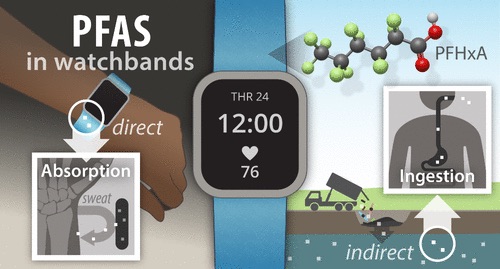Wearable technology like smartwatches and fitness trackers has become an integral part of modern fitness culture. These devices promise to monitor health metrics, improve athletic performance, and offer convenience in tracking personal goals. However, a recent study by researchers at the University of Notre Dame exposes a troubling truth: many smartwatches and fitness tracker bands contain alarmingly high levels of per- and polyfluoroalkyl substances (PFAS), also known as “forever chemicals.” These chemicals, linked to severe health risks, are absorbed through the skin, raising significant concerns for athletes who wear these devices regularly.
The study reveals widespread use of PFAS in smartwatch bands, particularly in materials like fluoroelastomers, which are synthetic rubbers marketed for their durability and sweat resistance. These substances are not only persistent in the environment but also accumulate in the human body over time, leading to chronic exposure. Athletes, who often wear these bands for extended periods and during intense physical activities, are particularly vulnerable to the health impacts of PFAS. This article explores the study’s findings, the risks of PFAS exposure, and practical steps athletes can take to protect themselves.
What Are PFAS and Why Are They Dangerous?
PFAS are a group of over 15,000 synthetic chemicals widely used for their water-resistant, stain-resistant, and heat-resistant properties. They are referred to as “forever chemicals” because they do not naturally degrade and persist in the environment for decades or longer. These substances are commonly found in products like non-stick cookware, waterproof clothing, and firefighting foams.
The health risks associated with PFAS exposure are well-documented and include:
- Cancer: Long-term exposure to PFAS has been linked to cancers of the kidney, liver, and testicles.
- Immune System Suppression: PFAS can impair the immune system, making the body more susceptible to infections and reducing the efficacy of vaccines.
- Hormonal Disruption: As endocrine disruptors, PFAS interfere with hormonal pathways, leading to imbalances that can affect energy levels, metabolism, and recovery.
- Liver and Kidney Damage: These organs are crucial for filtering toxins and maintaining overall health, but they are particularly vulnerable to the toxic effects of PFAS.
- Developmental Issues: In children and fetuses, PFAS exposure is linked to reduced birth weight, developmental delays, and other adverse outcomes.
The Notre Dame Study: Key Findings
The University of Notre Dame study examined 22 smartwatch and fitness tracker bands across various brands and price points. The researchers used advanced techniques, including particle-induced gamma-ray emission spectroscopy and liquid chromatography-mass spectrometry (LC-MS/MS), to detect and measure PFAS levels.
Among the key findings:
- PFAS Detection in 15 Out of 22 Bands: Total fluorine concentrations exceeded 1% in most bands, indicating the widespread use of fluoroelastomers.
- PFHxA Prevalence: Perfluorohexanoic acid (PFHxA), a short-chain PFAS compound, was the most frequently detected substance, with concentrations as high as 16,662 ng/g. PFHxA is linked to liver damage and is under regulatory review in the European Union due to its toxicity.
- PFOA Presence: Some bands also contained PFOA, a PFAS compound so toxic that the EPA has stated no safe level of exposure in drinking water.
- Dermal Absorption Risks: The study highlighted the potential for significant dermal absorption of PFAS, particularly during physical activity, when sweat and friction increase skin permeability.
Fluoroelastomers and Their Role in PFAS Exposure
Fluoroelastomers are synthetic rubbers valued for their resistance to oils, sweat, and environmental wear. These materials are frequently used in “sport” or “performance” smartwatch bands. However, their production involves PFAS as surfactants, resulting in residual amounts of these chemicals on the surface of the bands.
The Notre Dame study found that PFAS concentrations in some fluoroelastomer bands were comparable to levels found in firefighting gear, which is designed to withstand extreme conditions. This raises serious questions about whether such high PFAS levels are necessary in consumer products and why alternative, safer materials are not being prioritized.
Health Risks for Athletes
Dermal Absorption
Studies have shown that PFAS can penetrate the skin, especially during prolonged contact. Research indicates that up to 60% of certain PFAS compounds applied to a human skin model were absorbed. For athletes, who wear smartwatch bands during intense physical activities, the combination of sweat, heat, and friction enhances this absorption process.
Liver and Kidney Health
PFHxA, the most commonly detected PFAS in the study, is associated with liver toxicity. The liver is a critical organ for detoxifying the body, and its impairment can lead to fatigue, reduced performance, and long-term health issues. Similarly, PFAS accumulation in the kidneys can disrupt electrolyte balance and hydration, crucial factors for athletic recovery and endurance.
Hormonal Disruption
As endocrine disruptors, PFAS interfere with hormonal signaling, impacting metabolism, energy production, and recovery processes. For athletes, hormonal imbalances can result in decreased performance, slower muscle repair, and mental fatigue.
Immune System Suppression
Chronic PFAS exposure weakens the immune system, increasing the risk of infections and prolonged recovery times. This is particularly concerning for athletes, whose schedules demand peak physical health year-round.
The Role of EMFs: A Compounding Threat
Smartwatches and fitness trackers emit electromagnetic fields (EMFs), which exacerbate the oxidative stress caused by PFAS exposure. EMFs increase free radical production, leading to cellular damage, inflammation, and impaired recovery. This dual exposure to PFAS and EMFs creates a perfect storm of health risks for athletes.
EMFs emitted by wearable devices include non-ionizing radiation from Bluetooth, WiFi, and cellular connections. Devices with cellular connectivity, like the Apple Watch, emit particularly high levels of EMFs due to their constant communication with nearby cell towers. Research has shown that EMF exposure can:
- Increase Oxidative Stress: This leads to greater cellular damage, a key factor in both short-term inflammation and long-term health issues.
- Disrupt Sleep Cycles: EMFs suppress melatonin production, reducing sleep quality and impairing recovery.
- Exacerbate Hormonal Imbalances: Both PFAS and EMFs are linked to endocrine disruption, compounding the effects on energy levels, metabolism, and recovery.
The combination of these factors makes wearable devices a potential health hazard, especially for athletes who rely on them for extended periods.
Reducing EMF Risks
Athletes can take practical steps to reduce EMF exposure, such as using Airplane Mode on devices to disable wireless connectivity when not actively tracking. Switching to low-EMF devices, like the Oura Ring, can also significantly lower radiation levels without sacrificing tracking capabilities.
Aires Tech offers innovative solutions for athletes who rely on high-EMF devices and want additional protection. Products like the Lifetune Go and Lifetune Flex are designed to neutralize harmful EMF frequencies, reducing their biological impact. Aires Tech technology works by modulating EMFs into a form that the body can better tolerate, significantly lowering oxidative stress and inflammation caused by radiation. These products can be worn alongside smartwatches or fitness trackers, making them an excellent choice for athletes who want to balance the benefits of wearable technology with their long-term health.
Use code “MOL” to save 25% on Aires Tech EMF protection devices.
Practical Steps for Athletes
1. Choose Safer Materials
Opt for smartwatch bands made from silicone or other PFAS-free materials. Silicone bands are durable, comfortable, and free of the toxic chemicals found in fluoroelastomers.
2. Reduce Wear Time
Minimize the time spent wearing smartwatch bands, especially during non-workout periods. Removing the band allows the skin to breathe and reduces prolonged contact with harmful chemicals.
3. Clean Bands Regularly
Clean smartwatch bands with water and a gentle, non-toxic soap to reduce surface chemical residues. Avoid harsh cleaning agents, which may exacerbate the release of PFAS.
4. Advocate for Change
Support brands that prioritize transparency and safer materials in their products. Advocate for stricter regulations on PFAS in consumer goods and educate others about the risks associated with these chemicals.
Industry and Regulatory Solutions
The findings of the Notre Dame study underscore the urgent need for regulatory intervention and industry innovation. Policymakers must implement stricter regulations on PFAS use in consumer products, including smartwatch bands. The European Union’s proposed ban on PFHxA sets a precedent that should be adopted globally.
Manufacturers must prioritize research and development to create safer, PFAS-free materials that maintain the performance characteristics consumers expect. Greater transparency in product labeling and marketing is also essential, allowing consumers to make informed choices.
Conclusion
The widespread presence of PFAS in smartwatch and fitness tracker bands represents a serious public health concern, particularly for athletes who rely on these devices for performance tracking. The Notre Dame study highlights the need for immediate action to reduce exposure to these toxic chemicals and mitigate their long-term health impacts.
For athletes, the stakes are high. Choosing safer alternatives, limiting wear time, and supporting regulatory change are crucial steps in protecting health and ensuring wearable technology fulfills its promise of enhancing well-being rather than compromising it. Combined with strategies to minimize EMF exposure, these actions can help athletes lead healthier, more sustainable lives while raising awareness about the hidden risks of wearable devices. The time to act is now, before the cumulative effects of PFAS and EMFs create a broader public health crisis.









